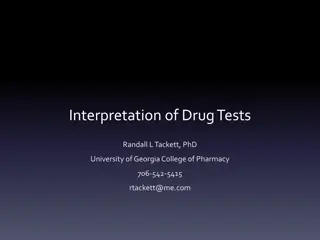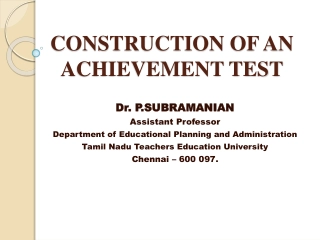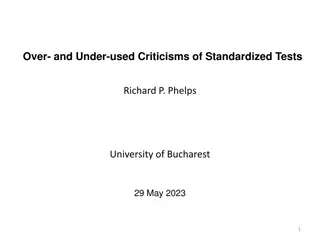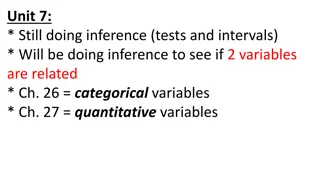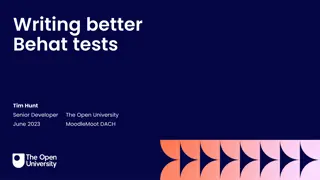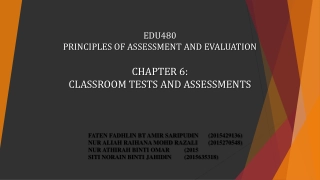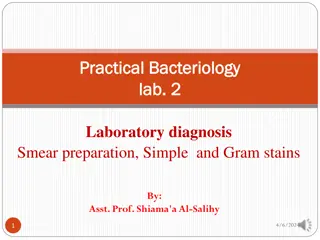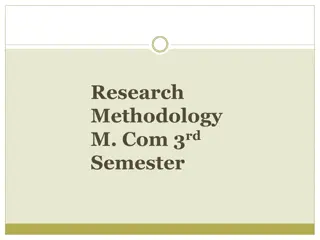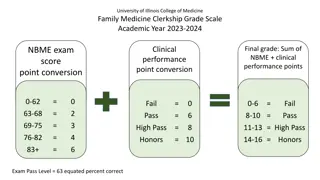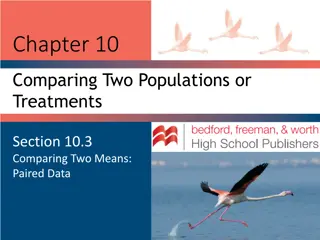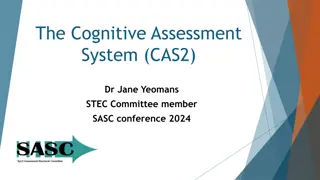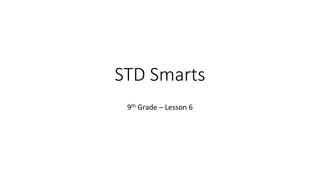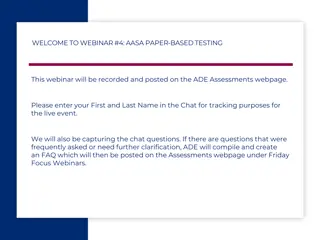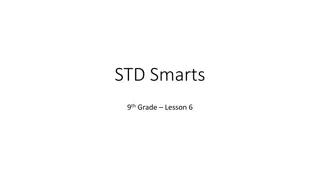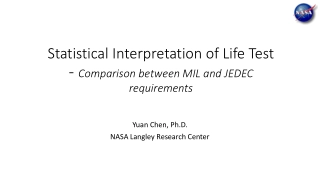Understanding Hypothesis Testing with T-Tests and Z-Scores
Explore the process of hypothesis testing using t-tests and z-scores, including limitations, steps, and proper statistical notation. Learn how to handle unknown values and the difference between one-tailed and two-tailed tests.
Download Presentation
Please find below an Image/Link to download the presentation.
The content on the website is provided AS IS for your information and personal use only. It may not be sold, licensed, or shared on other websites without obtaining consent from the author. Download presentation by click this link. If you encounter any issues during the download, it is possible that the publisher has removed the file from their server.
Presentation Transcript
BUILDING ON THE BUILDING ON THE LOGIC OF LOGIC OF HYPOTHESIS HYPOTHESIS TESTING: T TESTING: T- -TESTS TESTS
Limitations of hypothesis testing using z-scores 1. Our sample must be large (> 30) in order for the Central Limit Theorem to kick in . 2. must be known. This is a more serious limitation because it is almost impossible to know in the real world.
What do we do if is unknown? Just like we did with confidence intervals: 1. Use s as an estimate of 2. Use t as our test statistic instead of z The basic steps for conducting t-tests 1. Determine the value for tcrit 2. Calculate tobs 3. Compare tobswith tcrit
Step 1: Determining tcrit tcritdepends on the degrees of freedom; df = n-1 If = .05, and n = 10: t( =.05; 9) = 2.262 *If specific df is not listed; look up t values for df in between and then use the larger the larger t value
Step 2: Calculating tobs zobs zobs=M 0 / n ( ( n s/ tobs tobs=M 0 ) s/ n ( ) The only difference is that s replaces NOTE: is an estimate of SE ) Step 3: compare tobs withtcrit Exactly the same as before.
Proper Statistical Notation Old school style Old school style t (df) = t-observed, p < alpha OR p > alpha t (24) = 2.625, p < .05 Code for: With degrees of freedom of 24, our t-observed value was 2.625 and the probability of getting this value or one more extreme if the null were true is less than a 5% chance. New APA style New APA style t (24) = 2.625, p = .025 (exact p can only be calculated using a computer)
Two-tailed vs. One-tailed tests Two Two- -tailed tailed: : observing a sample mean in either the upper or lower tail of the sampling distribution would be theoretically meaningful Ho: = some value Ha: some value Rejection region split between two tails: /2 in upper tail, /2 in lower tail.
Two-tailed vs. One-tailed tests One One- -tailed tailed: : observing a sample mean in only one of the two tails of the sampling distribution would be theoretically meaningful Ho: some value OR some value Ha: < some value OR > some value Rejection region located entirely in one tail; EITHER upper tail OR OR in lower tail. EITHER in
Whats a one-tailed test? Take a minute to think about a statistical question for which it would make sense to conduct it as a one-tailed test. It can be a practical question or a research question or even a fun question. Last class, we asked questions about whether alcohol consumption differed from normal during 2020 due to the pandemic. What would be the null and alternative hypotheses if this was conducted as a two What would be the null and alternative hypotheses if this was conducted as a one two- -tailed test tailed test? one- -tailed test tailed test?
Comparing the results of one- and two-tailed t-tests Do in class??? You lost a lot of money at the track and were forced to become the personal statistician of notorious underworld crime boss Big Lou . Big Lou wants to know if his son Moderately-Sized Lou is stealing from his gambling operation. Before Lou Jr. took over the operation, it used to gross $3500 per night ( ). Big Lou tells you, I don t care if he is grossing more than $3500, I only care if he s grossing less. Got it?!
Comparing the results of one- and two-tailed t-tests Do in class??? At this point, you could give Big Lou a lecture regarding the theoretical considerations that guide the choice between one- and two-tailed tests, but I would not be so bold... You sample the gross earnings of the casino over the next 25 nights. The average of the sample is $3338; s = 450. Is Moderately- Sized Lou going to sleep with the fishes? = .05?
Do in class??? $3,500 Lou Jr. Lou Jr. is ok! gets whacked
Comparing the results of one- and two-tailed t-tests Do in class??? Gross $3500 per night ( ) Sample 25 nights, M =$3338; s = 450. Step 1 Step 1: Big Lou has asked us to conduct a one-tailed test with the entire rejection region in the lower tail. Thus, our null and alternative hypotheses will be as follows: Step 2 Step 2: Ho: 3500 Step 3 Step 3: Ha: < 3500 Step 4 Step 4: = .05 Step 5 Step 5: tcrit ( =.05, df = 24; 1-tailed) = -1.711. Negative value! M 3338 3500 162 Step 6 Step 6: : tobs = = = = 8 . 1 0 90 / 450 / 25 s n
Comparing the results of one- and two-tailed t-tests Do in class??? Gross $3500 per night ( ) Sample 25 nights, M =$3338; s = 450. Step 7 Step 7: Our observed t falls in the rejection region. Therefore, we would REJECT REJECT the null: t (24) = -1.8, p <.05 Step 8 Step 8: Interpret the results
Big Bad Lou as a Two-Tailed Test Do in class??? Although it would be unwise for you to challenge Big Lou s decision to run a one-tailed test, the same is not true for Mrs. Lou. She loves her baby boy and wisely asks you to conduct a two-tailed test, just to see what would happen. After all, wouldn t Lou Jr. deserve a big raise if receipts from the gambling operation increased rather than decreased? Bear in mind that, just like with selecting a value for , the time to make a decision regarding whether to run a one- or two-sampled test is BEFORE BEFORE you have seen the data.
Following mama Lous request Do in class??? Step 1 Step 1: Because we have decided to conduct a two-tailed test, our statistical hypotheses would be as follows: Step 2 Step 2: Ho: = 3500 Step 3 Step 3: Ha: 3500 Step 4 Step 4: = .05 Step 5 Step 5: tcrit( =.05, df = 24, 2-tailed) = 2.064. Step 6 Step 6: The observed value of our test statistic does not change: tobs = -1.8
Following mama Lous request Do in class??? Step 7 Step 7: Our observed t DOES NOT Therefore, we would FAIL .05 DOES NOT fall in the rejection region. FAILTO TOREJECT REJECT the null: t (24) = -1.8, p > Ethics Ethics: Be judicious. Choose before you see your data! Step 8 Step 8: Interpret results
My opinion on one-tailed tests. ONE-TAILED TESTS ARE INAPPROPRIATE UNLESS YOU HAVE AN EXTREMELY GOOD REASON FOR USING THEM BEFORE YOU RUN YOUR EXPERIMENT. I HAVE NEVER SEEN A STRONG ARGUMENT FOR WHY ONE WAS APPROPRIATE. EVER!!!! EVER!!!! .
Ways to reject the null Critical value: Critical value: tobs > tcrit OR zobs > zcrit P P- -value: value: p-value < alpha
Reporting the results of a t-test Amherst College students consumed an average of 3.2 pieces of fruit per day (s = 2.57). These data did not provide enough evidence to conclude that Amherst College students differed from the national average in terms of fruit consumption: t (29) = 1.495, p = .15. 1. Mean 2. SD 3. Df 4. tobs 5. p-value
Important points about the p-value method 1. The p-value method and the critical value method will always produce the same decision regarding the null. 2. The p-value method gives us more information than the critical value method, in that it tells us where our sample mean fell in the sampling distribution What if p = .06? (a marginally significant result) A lower p A lower p- -value does not imply a bigger effect value does not imply a bigger effect even though all things being equal a lower p-value implies a larger difference between M and 0. What is the easiest way to obtain a smaller p-value in an experiment?
Getting a smaller p-value through the magic of Math!! ? =? ? ? =103 107 15 = 4 = 1.33;? ????? .20 3 ? 25 ? =? ? ? =103 107 15 = 4 1.5= 2.67;? ????? .01 ? 100 Same difference between the means, but a much smaller p-value when n is large.
Effect size- Cohens D Effect size Effect size a statistical procedure for determining the magnitude of an experimental manipulation. d dM = cohen' d s = M cohen' d s s dm = the difference between the sample mean and the expected value of Cohen s d Cohen s d 0 < d < .2 0 < d < .2 .2 < d < .8 .2 < d < .8 d > .8 d > .8 Evaluation Evaluation Small Small Medium Medium Large Large 162 Effect size for the Big Lou question: mean difference: 3338 vs. 3500 = 162 = = d 36 . 450
Statistical significance isnt everything A large school district decides to implement a new drug awareness program for high school students. They select 1,000 students from the district to participate. Prior data suggested that the average high school student in this district has 4.2 alcoholic drinks per month, =2. The district administers the new program and finds that afterwards the average is now 4 drinks per month. Should they adopt the new intervention program?
Statistical significance isnt everything Mean = 4 drink per month; n = 1000 Ho: = 4.2 drinks Ha: 4.2 drinks = .05 M 2 . 4 2 . 4 = = = . 3 16 0 Zobs 06 . / 2 / 1000 n .0008 x 2 = .0016 < alpha (.05): therefore therefore reject the null reject the null. Decision: Decision: the intervention significantly reduced drinking behavior. cohen' 2 . d = = = d s 1 . M 2 Problem???






